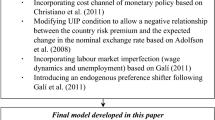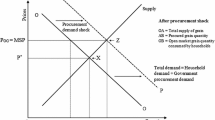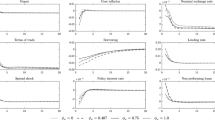Abstract
We develop a small open economy DSGE model usable for monetary policy in Sub-Saharan Africa. In this paper we apply the model to quarterly data from Ghana from 1981–2007. We find that permanent, but not transitory, technology shocks are the most important source of fluctuations. We find that the estimated monetary policy rule suggests that policy is aimed almost exclusively at fluctuations in output and ignores inflation, imports and exports. A negative result is that there appears to be significant issues in identifying some important parameters.


Similar content being viewed by others
Notes
The domestic financial markets are assumed to be complete, thus each household can insure against any type of idiosyncratic risk through the purchase of the appropriate portfolio of securities. This prevents the frictions from causing the households to become heterogenous, so the representative agent framework is still valid for this economy.
The value of the real cash holdings is scaled by z t in order to make them stationary.
In equilibrium it will be the case that \(\triangle_{t}=0\), since all households are identical.
The function a(u) is the utilization cost function, satisfying a(1) = 0, a ″ ≥ 0 and a ′ = (1 − τ k)r k in steady state.
\(u_{t}=K_{t}/\overline{K}_{t}\).
The function \(\Phi(\frac{A_{t}}{z_{t}},\tilde {\phi}_{t})=\exp(-\tilde{\phi}_{A}(\frac{A_{t}}{z_{t}}-\overline{A})+\tilde{\phi}_{t})\) is strictly decreasing in A t and satisfies Φ(0,0) = 1.
Compared to Adolfson et al. (2007) we do not consider wage stickiness for simplicity.
Ki,t can differ from the physical capital stock since the model allows for variable capital utilization.
Since the intermediate firms have monopoly power the fixed cost is necessary to insure that profits are zero in steady state. Following Christiano et al. (2005) ϕ is set such that this holds.
For a given P i,t the firm is constrained to produce Y i,t.
By assumption, a fraction, ν t , of the intermediate firm’s wage bill has to be financed in advance.
\(R_{t}^{k}\)—the gross nominal rental rate per unit of capital services, W t —the nominal wage rate per unit of aggregate, homogeneous, labour, Kt + 1—capital services in period t + 1 and \(\overline{K}_{t+1}\)—the physical capital stock at t + 1.
Since all firms are virtually identical and they will always choose the same price the index i is dropped to simplify the notation.
All importing firms, of a certain type, that are allowed to reoptimize their price, in a given period, will choose the same price, therefore it is not necessary to use a firm index.
By assumption in steady state λ x = 1.
All such estimates resulted in multiple equilibria.
The posterior coverage intervals for the shocks which contribute a significant amount of volatility are fairly tight. For the other shocks, the contribution is essentially zero so posterior coverage intervals are not very interesting.
References
Adolfson M, Laseen S, Linde J, Villani M (2007) Bayesian estimation of an open economy dsge model with incomplete pass-through. J Int Econ 72(2):481–511
Almeida V (2009) Bayesian estimation of a DSGE model for the Portuguese economy. Bank of Portgual Working Papper 14:2009
Altig D, Eichenbaum M, Linde J (2005) Firms-specific capital, nominal rigidities and the business cycle. Working Paper
Benigno P (2001) Optimal monetary policy in a currency area. CEPR Discussion Papers 2755, C.E.P.R. Discussion Papers
Broda C (2004) Terms of trade and exchange rate regimes in developing countries. J Int Econ 63(1):31–58
Calvo GA (1983) Staggered prices in a utility-maximizing framework. J Monet Econ 12(3):383–398
Chia W-M, Alba JD (2006) Terms-of-trade shocks and exchange rate regimes in a small open economy. Econ Rec 82(s1):S41–S53
Christiano LJ, Eichenbaum M, Evans C (2005) Nominal rigidities and the dynamic effects of a shock to monetary policy. J Polit Econ 113(1):1–45
DeJong DN, Ingram BF, Whiteman CH (2000) A Bayesian approach to dynamic maCRoeconomics. J Econom 98(2):203–223
Homaister AW, Roldós J (1997) Are business cycles did’erent in Asia and Latin America. IMF Work Pap 97/9
Homaister AW, Roldos JE, Wickham P (1998) MaCRoeconomic .uctuations in sub-saharan africa. IMF Staff Pap 45(1):5
Kose MA (2002) Explaining business cycles in small open economies: how much do world prices matter? J Int Econ 56(2):299–327
Kose MA, Riezman R (2001) Trade shocks and macroeconomic .uctuations in Africa. J Dev Econ 65(1):55–80
Lundvik P (1992) Business cycles in a small open economy: Sweden 1871–1987. In: Mimeo. Stockholm University, Stockholm
Mendoza EG (1995) The terms of trade, the real exchange rate, and economic uctuations. Int Econ Rev 36(1):101.37
Otrok C (2001) On measuring the welfare cost of business cycles. J Monet Econ 47(1):61–92
Schorfheide F (2000) Loss function-based evaluation of DSGE models. J Appl Econ 15(6):645–670
Smets F, Wouters R (2007) Shocks and frictions in us business cycles: a Bayesian dsge approach. Am Econ Rev 97(3):586–606
Author information
Authors and Affiliations
Corresponding author
Rights and permissions
About this article
Cite this article
Houssa, R., Otrok, C. & Puslenghea, R. A Model for Monetary Policy Analysis for Sub-Saharan Africa. Open Econ Rev 21, 127–145 (2010). https://doi.org/10.1007/s11079-009-9142-8
Published:
Issue Date:
DOI: https://doi.org/10.1007/s11079-009-9142-8




